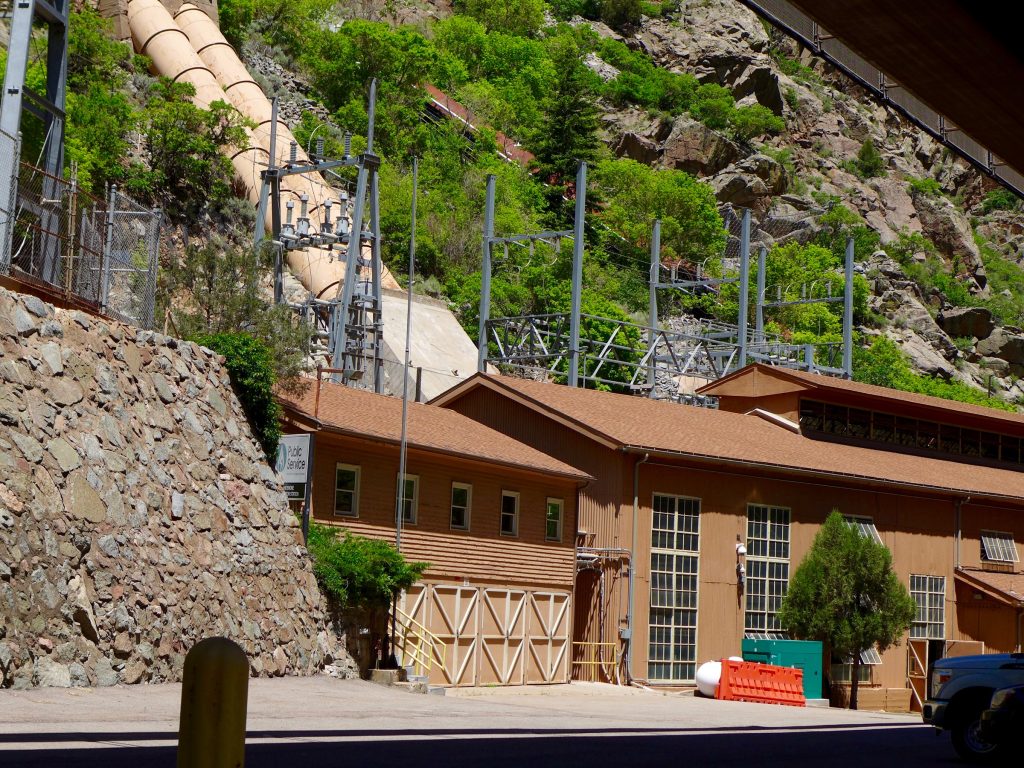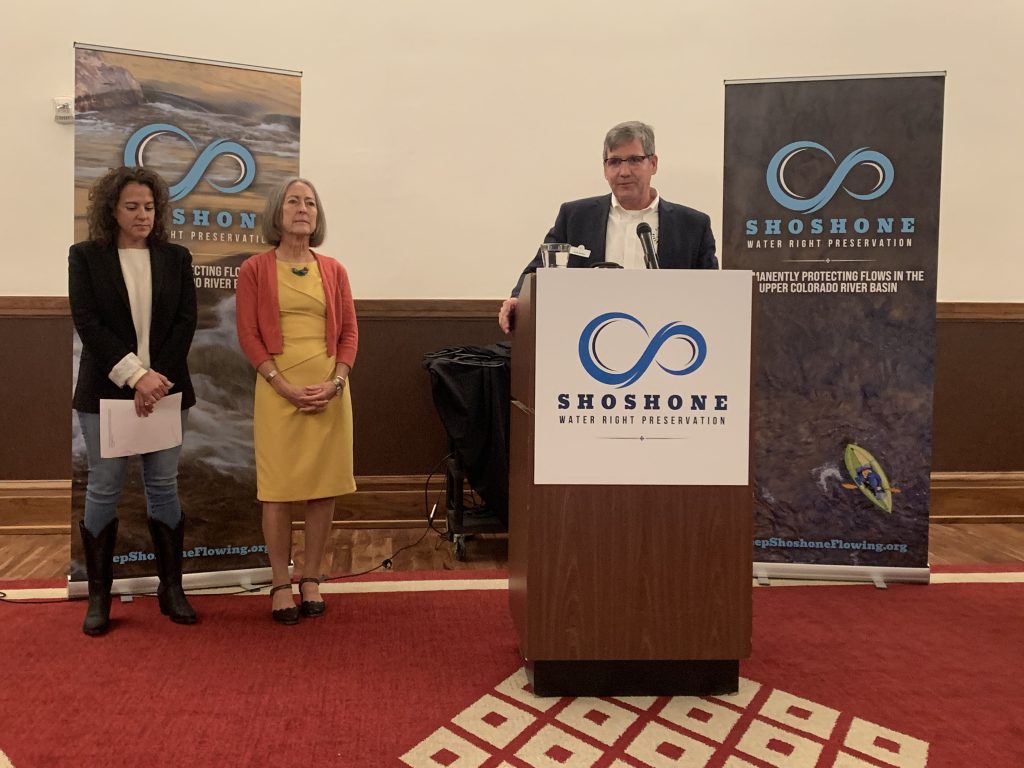Colorado water board to decide if Shoshone water rights can be used for environment

Brent Gardner-Smith/Aspen Journalism
The state water board will decide this week whether to approve a proposal from the Western Slope that would allow one of the oldest and most powerful water rights on the Colorado River to be used to benefit the environment.
The Colorado Water Conservation Board is set to hear nearly 13 hours of testimony on Wednesday and Thursday in Durango from the Glenwood Springs-based Colorado River Water Conservation District and its supporters, as well as four Front Range water providers, who requested the hearing because they object to certain aspects of the proposal.
All the parties participating in the contested hearing agree that the water rights associated with the Shoshone hydropower plant in Glenwood Canyon are beneficial for the environment and would like to keep this water flowing west. But like many things regarding the Colorado River, the devil is in the details.
“We all agree that the environment will be protected and we do support it,” said Alex Davis, assistant general manager of Aurora Water. “But if the CWCB were to simply accept the right and sign the instream-flow agreement that the River District has proffered, that would be endorsing the River District’s technical position and discretion to call issue.”
Representatives from Denver Water, Northern Water and Colorado Springs Utilities declined to speak with Aspen Journalism for this story.

Support Local Journalism
The River District, which represents 15 counties on the Western Slope, is some of the oldest and largest nonconsumptive water rights on the Colorado River from Xcel Energy for nearly $100 million. The water rights, which are tied to the hydropower plant, are essential for downstream ecosystems, cities, endangered fish, and agricultural and recreational water users. The plan has widespread support from Western Slope water users, who say this water is crucial to the health of their communities.
As part of the deal, the Colorado Water Conservation Board must agree to add to the hydropower right an instream-flow water right to benefit the environment and then sign on as a co-applicant on the water court case that would make the change official. The Colorado Water Conservation Board is the only entity in the state allowed to hold instream-flow water rights, which are designed to keep a minimum amount of water in rivers to preserve the natural environment.
Adding this instream-flow right would allow water to keep flowing west even when the 116-year-old plant — which is often down for repairs, and vulnerable to wildfire and mudslides in the steep canyon — is not operating, an occurrence that hasin recent years.
Critically, because the plant’s 1902 water rights are senior to many other water users, Shoshone can force upstream water users to cut back. The Shoshone call can command the flows of the Colorado River and its tributaries upstream all the way to the headwaters. This means it can also “call out” junior Front Range water providers who take water across the Continental Divide via transmountain diversions.
The hearing reignites rivalries between the Western Slope and the Front Range, which takes about 500,000 acre-feet of water a year from Colorado River basin headwaters across the Continental Divide, a practice that can leave Western Slope streams depleted.
It also raises an unanswerable question about who is more deserving of the state’s ever-dwindling water supply: the Western Slope, where the majority of the water originates and which looms large in Colorado’s cultural identity with its rural character, outdoor recreation and small family farms, or the Front Range, which is the urban population center and economic engine of the state. Western Slope water users often feel that Front Range growth has come at their expense.
“I think everybody’s feeling the pressure of climate change and reductions in the volume in the river will create challenges for everyone,” said Andy Mueller, general manager of the Colorado River District. “My belief is that we succeed in the face of a challenge like that if we collaborate in the manner that we’re proposing in this instream flow. We don’t succeed if we put one water user segment over another, if we put cities over the environment, if we put cities over agriculture.”

Historic use
Determining past use of the Shoshone water rights is important because it will help set a limit for future use, as the instream-flow water right will be set according to the historic hydropower usage. Although changing the use of a water right is allowed by going through the water court process, enlarging it is not. The amount pulled from and returned to the river must stay the same as it historically has been.
But putting a precise number on how much water is associated with the Shoshone right has been a major point of contention between the Front Range and the River District. Aurora Water, Denver Water, Northern Colorado Water Conservancy District and Colorado Springs Utilities say the River District’s preliminary estimate of the hydro plant’s average annual use of 844,644 acre-feet, using the period between 1975 and 2003, is flawed and would be an expansion of the historical use of the water right that harms their interests.
Usually, the water court process determines the exact amount of a water right’s historical use, which will be the next step if the Colorado Water Conservation Board approves the instream-flow right. In an effort at transparency and an attempt to streamline the water court process, the River District publicly released its historic use estimates in application last year, which the Front Range parties have latched on to as problematic. They believe that if the Colorado Water Conservation Board accepts the water right for instream-flow use, it would be a tacit acceptance of the River District’s numbers.
“If the CWCB were to just accept the River District’s analysis, it would vastly expand the water right,” Davis said.
The River District proposed that the on this aspect and let a water court decide, but that proposal was not adopted.
Including the past 20 years, when the plant was often offline, is not representative of the water right’s historic use and would lower the average — something that would benefit the Front Range, Mueller said.
“It would create a windfall for the Front Range transmountain diverters to increase the yield of their junior water rights so they can have more water to fuel future growth,” Mueller said. “That’s all it would do at the expense of the Colorado River and the environment and the water users over here.”

Who gets to call?
Another major point of contention is who — the River District or the Colorado Water Conservation Board— would have the authority to control Shoshone calls. The River District is proposing co-management by both entities, but the Front Range parties would like the Colorado Water Conservation Board to retain sole authority. Aurora would also like to preserve a long-standing agreement that would “relax” the Shoshone call to allow Front Range water providers to keep taking water in times of extreme drought — something Mueller said the River District will continue to allow.
“We feel pretty strongly that the CWCB needs to be the entity with the power to determine whether or not to put on that call,” Davis said. “In those dramatic situations, we want to make sure that the cities are not impacted negatively by this if we are looking at significant shortages.”
Mueller said cutting the River District — which is charged with protecting, conserving, using and developing water within its boundaries — out of decision-making about one of the most important water rights and associated calls on the Western Slope would be a deal-breaker.
“If the CWCB board was inclined to say, ‘We don’t agree with the co-management of this water right and we think only the CWCB should operate it,’ well, the West Slope would have to walk away from this instream-flow process,” Mueller said. “It would be over. We would terminate our contract with Xcel and the state would lose an historic opportunity to preserve the Colorado River flows … . We’d have to find another method of gaining control over those water rights.”
In its written testimony, Boulder-based conservation group Western Resource Advocates says the Front Range parties are asking the Colorado Water Conservation Board to make decisions outside its authority. The only issue up for consideration by the Colorado Water Conservation Board should be whether the Shoshone water rights should be acquired for instream-flow purposes, WRA said. WRA is also representing several other nonprofit environmental organizations that have a stake in the Colorado River: American Rivers, Conservation Colorado, National Audubon Society and Trout Unlimited.
“The Colorado Water Conservation Board must seize this once-in-a-lifetime opportunity to acquire the Shoshone water rights and protect Colorado’s streams,” WRA senior staff attorney John Cyran said in an emailed statement. “None of the parties to this hearing dispute this acquisition would benefit river health, fish and wildlife, river recreation and Colorado’s West Slope communities. The details will be ironed out in water court.”
The Front Range parties have also asked for an extension to give the two sides more time to hash out agreements before the Colorado Water Conservation Board makes a decision. But that seems unlikely as neither the River District, which must be the one to grant the extension, nor attorneys for the Colorado Water Conservation Board think it would be productive. They instead want to rely on the subsequent water court process with its enforced deadlines to work out the nitty-gritty issues.
“This project has been in the works for years, but discussions are routinely stalled and the parties do not seem to have made any progress toward resolution,” reads the testimony from Jen Mele, attorney for the Colorado Attorney General’s Office.
The board has three choices next week: They can approve the acquisition of the water rights as proposed; they can deny the acquisition; or they can make changes to the proposal and approve the amended proposal. The hearing, which will take place at Fort Lewis College in Durango, is scheduled from 12:20 to 6 p.m. on Wednesday and from 8:30 a.m. to 5 p.m. on Thursday.









